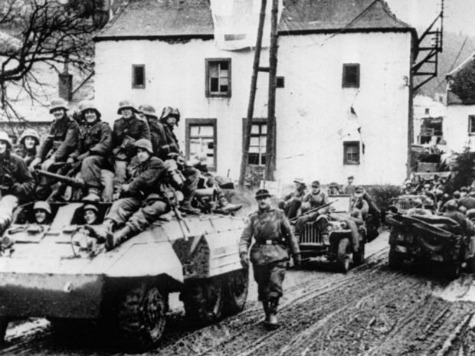
Today marks the 70th anniversary of the Battle of the Bulge, one of the greatest victories in the history of the United States military. However, if not for a few brilliant maneuvers by Allied commanders and the incredible bravery and fighting spirit of the common fighting man, the history of World War II may very well have ended in a truce with Nazi Germany rather than its unconditional surrender.
If there is a lesson that Americans can take from the near disaster that the Battle of the Bulge almost became, it is to never underestimate an enemy, even one that seems battered, broken and defeated. Michael Peck recently wrote in The National Interest that “the Battle of the Bulge is more than history. It is a primer of valuable lessons that still apply today.” Channelling the famed Chinese strategist Sun Tzu, Peck said that the first and most important lesson that can be learned from the Battle of the Bulge is, “never, ever underestimate the enemy.”
Though nearly all of Adolph Hitler’s top commanders were firmly against the all-out Ardennes offensive, the Führer believed that this was Germany’s chance to stave off certain defeat. The Ardennes Forest was thick with trees that would make armored attack difficult, the roads were poor and iced over, and supplies were so thin that almost any sustained offensive would exhaust them. The Soviet army was relentlessly surging toward Berlin on the Eastern front, and the overwhelming amount of men and materiel pouring into Western Europe from America’s “Arsenal of Democracy” made the German army’s problems near insurmountable. Headed for a total defeat, a last minute attack where the enemy least suspected it was arguably the only thing that could save Nazi Germany.
Although the military strategy left Hitler’s top commanders and future historians baffled, a recently-released book has come up with a new hypothesis for the reasons behind the risky attack. Historian Peter Caddick-Adams, author of Snow & Steel: Battle of the Bulge 1944-45, argues that the reasons for the assault were primarily political. In an interview with National Geographic, Caddick-Adams said that during the course of his research he “came to the conclusion that this is rather Hitler’s attempt to reassert his personal political control over the German general staff and the entire Nazi hierarchy. It’s a reaction to the von Stauffenberg bomb attempt on his life on the 20th of July, 1944.”
So, in the months leading up to the Ardennes surprise attack, Hitler held back his best tanks, equipment, and veteran troops. This action lulled some Allied commanders into a false sense of security, believing that the German war machine had been permanently crippled. In fact, the Ardennes front had been so quiet for such a long time that Allied commanders began calling it the “ghost front.”
With Christmas fast approaching, and the war’s end seemingly just around the corner, the last thing that homesick soldiers wanted or expected was a sudden, ferocious, life or death struggle with the cream of the German military. Nevertheless, on December 16, 1944 the German army smashed through the Ardennes Forest in East Belgium, taking allied forces completely by surprise. The attack initially included around 200,000 men and over 600 tanks against 80,000 Allied troops and 400 tanks, who, for the first time since the early days of fighting in France found themselves badly undersupplied and outnumbered.
The fighting that December in the frigid Ardennes Forest would be some of the most intense of the war as allied soldiers fought bravely against incredible odds. American troops cut off in the Belgian city of Bastogne did not even have winter clothing and supplies, but they had to hold out to prevent the Germans from taking the invaluable city of Antwerp. They had to rely of the local population that rushed to bring them food and supplies and hope that reinforcements would reach them in time. But when asked by the German command if they would surrender, American General Anthony McAuliffe of the 101st Airborne famously said, “Nuts!”
If not for the heroics of Gen. George Patton and his Third Army, the beleaguered forces at Bastogne might have been overrun. Patton, who had studied briefly at the Virginia Military Institute, conducted the most daring and improbable march since Stonewall Jackson’s legendary Shenandoah Valley Campaign in 1862.
Surveying the scope of the German attack, the famously brash Patton quipped to fellow General Omar Bradley, “Brad, this time the Kraut’s stuck his head in the meat grinder, and I’ve got hold of the handle.”
After a brilliant and near miraculous drive through Germany, Patton’s Third Army relieved Bastogne on December 26, 1944. It was an improbable, late Christmas gift delivered by one of the most daring campaigns in world history. The Battle of the Bulge ended with a tremendous victory for the Allies, but it came at a terrible cost. Over 69,000 casualties had been sustained in that brutal winter fighting, a terrible price to pay for victory.
Americans should take to heart to impact of underestimating a seemingly defeated foe. In 2013, President Barack Obama said that Al Qaeda had been “broken apart” and was “very weak.” Many believed that radical Islam, which had been responsible for the brutal murder of thousands of Americans on September 11, 2001, was waning and on the decline.
With the recent rise of the Islamic State in the Middle East, and organization better organized and more well funded than Al Qaeda ever was, it is apparent that enemies of the United States remain a serious threat. Learning valuable lessons from 70 years ago may allow America to avoid paying a terrible price for underestimating a dangerous and determined enemy.

COMMENTS
Please let us know if you're having issues with commenting.